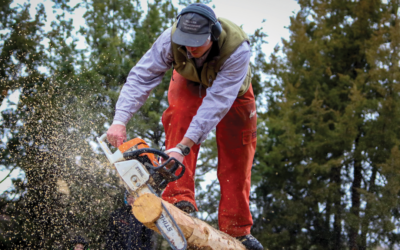Foodies globetrot to discover new dishes and culinary preparations. Many of those delicious adventures can also be found in our region’s ethnic restaurants, offering
a passport to taste the world without having to hop on a plane.
Mt. Asian One – Loveland
When you walk into Mt. Asian One in Loveland, a locally owned restaurant with Chinese, Japanese and sushi dishes, the reprieve from U.S. 34’s hustle and bustle is immediate.
Glimmering granite and cool gray, white and black tones contribute to that serenity, as does the mural of a beautiful woman and a white crane, a Chinese cultural symbol. It’s a focal point that draws guests into an ancient realm where art and design are integral to the dining experience.
Daniel Liu and his wife, Kimmy, the graphic designer who created the mural for the wallpaper, opened Mt. Asian One with Kimmy’s parents in 2021.
“We opened it because Kimmy’s family are good cooks, and I learned sushi and ramen from a Japanese sensei in Los Angeles’ J-town,” Liu says.
Liu immigrated from Canton, China (now called Guangdong) to San Gabriel, Calif., when he was 17. He’s worked in the restaurant industry since 2003, when he began as a server and bartender at what he calls “ABC restaurants,” ones owned by American-born Chinese that cater to American tastes. He also has a degree in graphic arts, which helps him create unique dishes.
“As a graphic designer, I see sushi as an artistic outlet where I can use my imagination to create the food and how it will be presented on the plate,” Liu says.
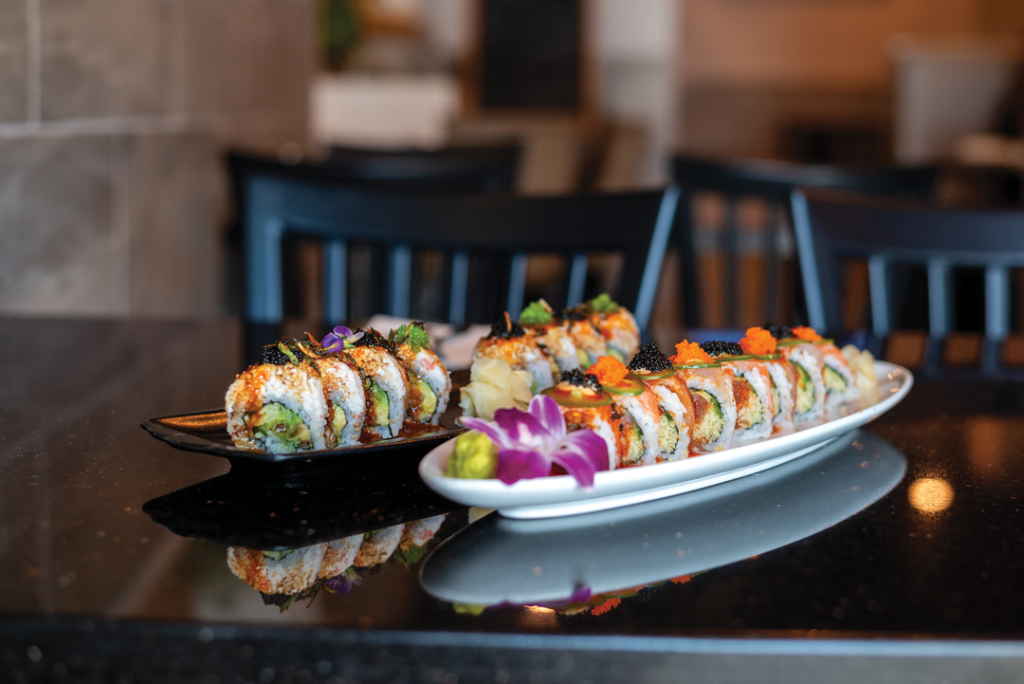
The Kiss of Fire and Bad Attitude sushi rolls from their signature maki selection.
Liu moved to Northern Colorado in 2015 to take over a friend’s restaurant, which he saw as an opportunity to present authentic dishes from his home country.
“American Chinese food is awful. It doesn’t taste Chinese,” he says. “It’s so sweet from the sugar; there is more soy and white sauce.”
Liu says authentic Asian dishes are stir-fried dry style with dipping sauce on the side, and oyster sauce, brown sugar, ginger and onion add flavor. Americans are accustomed to a wet style with a lot more sauce.
“Every time we make pad thai dry style, customers ask for more sauce,” Liu says.
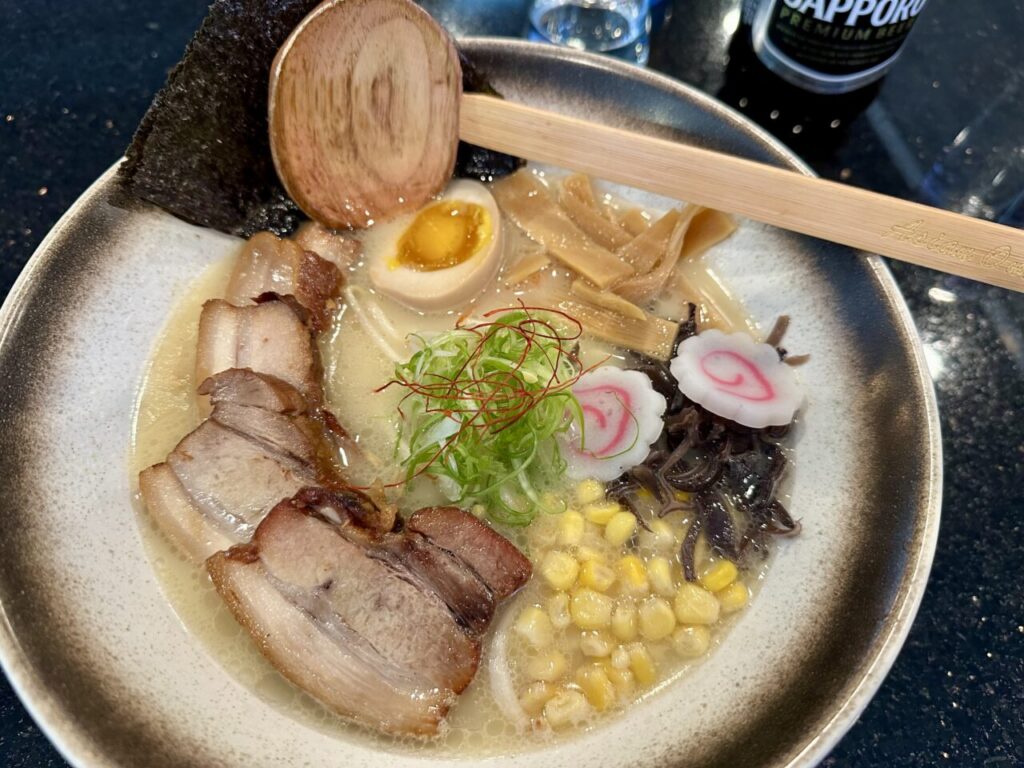
Tonkatsu ramen at Mt. Asian One in Loveland. Photo by Emily Kemme.
Mt. Asian One is known for the tonkotsu ramen Liu’s sensei taught him how to make. It has chewy soba noodles swimming in rich broth made from pork bones and pigs’ feet that are simmered for 10 hours. The gelatinous connective tissues in the feet are the key to thickening the broth, and it’s good for your skin, Liu says. Unlike some ramen shops, he says his broth is made from scratch instead of powdered products.
Liu knows not everyone can cook with his level of complexity. Sourcing diverse ingredients, like the kind he uses in his signature roast duck, is difficult for the home cook. But he believes a demand for Mt. Asian One’s homestyle cooking will develop. Sushi also took time to catch on with American palates, he says.
That’s why Liu created a “secret” menu with Chinese dishes that aren’t on the regular menu—though it’s not that secret because it’s written on a chalkboard propped on the sushi bar.
In addition to roast duck, Liu suggests starting your exploration of authentic Chinese cuisine with mapo tofu, a silky tofu and ground pork dish dotted with Sichuan peppercorns that lend a citrusy fragrance and subtle heat that leaves your tongue tingling. The secret menu adds 20 items to the restaurant’s substantial variety of choices, offering a chance to taste what true Chinese cooking is about.
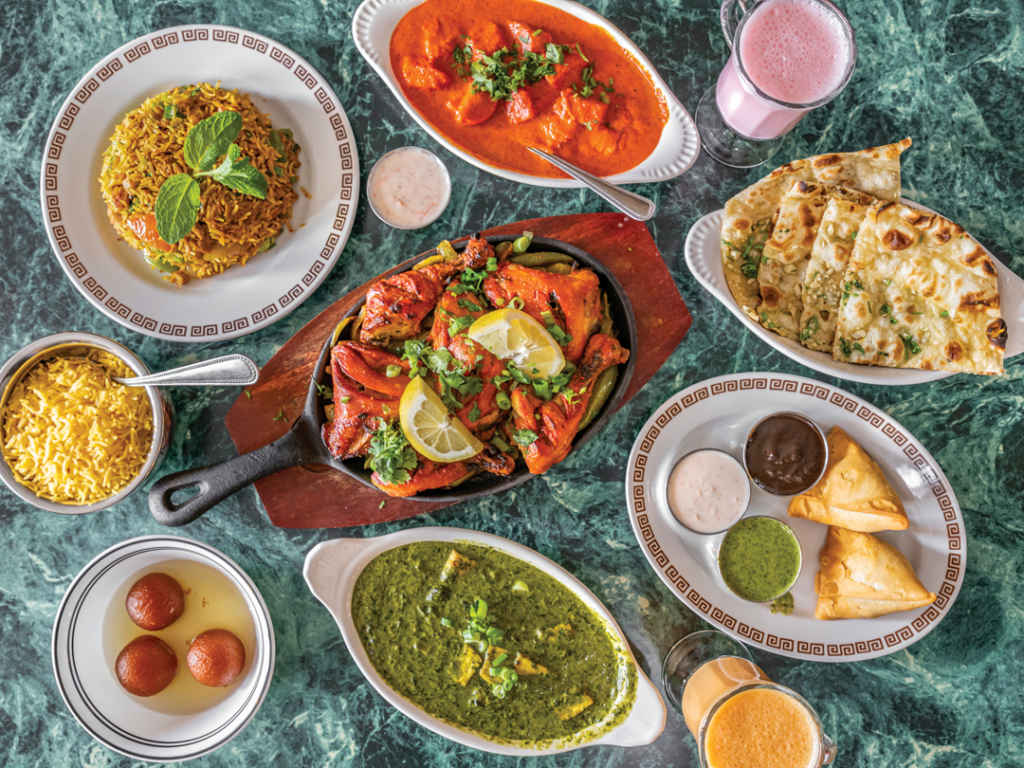
Many dishes from Bhansa Restaurant.
Bhansa Restaurant – Greeley
Rupesh Nyaupane learned how to cook traditional Nepalese dishes in his family’s restaurant in Kathmandu, the country’s capital. Situated high in the Himalayas, the ancient city brims with natural beauty and intricate architecture.
Rupesh and his brother, Prashand, co-own Bhansa with their parents, Bal and Cinta. All four bring unique skill sets to the family business. Bal and Rupesh, who earned a master’s degree in business administration from Pokhara University, handle the business side. Prashand designed the cocktail and bar menus based on his previous bartending experience. Cinta prepares house specialties, like momo (filled dumplings that can be steamed or deep-fried), vegetable samosas (dumplings stuffed with potatoes and vegetables and fried until crispy), pakoras (vegetables fried in chickpea batter) and naan bread (a flat leavened bread baked in a clay tandoori oven).
The family immigrated to the U.S. in waves. The elder Nyaupanes moved to the U.S. in 2008 for six months and returned to Colorado in 2014. The brothers arrived between 2016 and 2018.
At Bhansa (meaning “kitchen” in Nepalese), the Nyaupanes prepare dishes similar to those they cooked in Kathmandu. Rupesh says the curry spices for their masala (or spice mixture) are the same, but their recipes are adapted for American tastes.
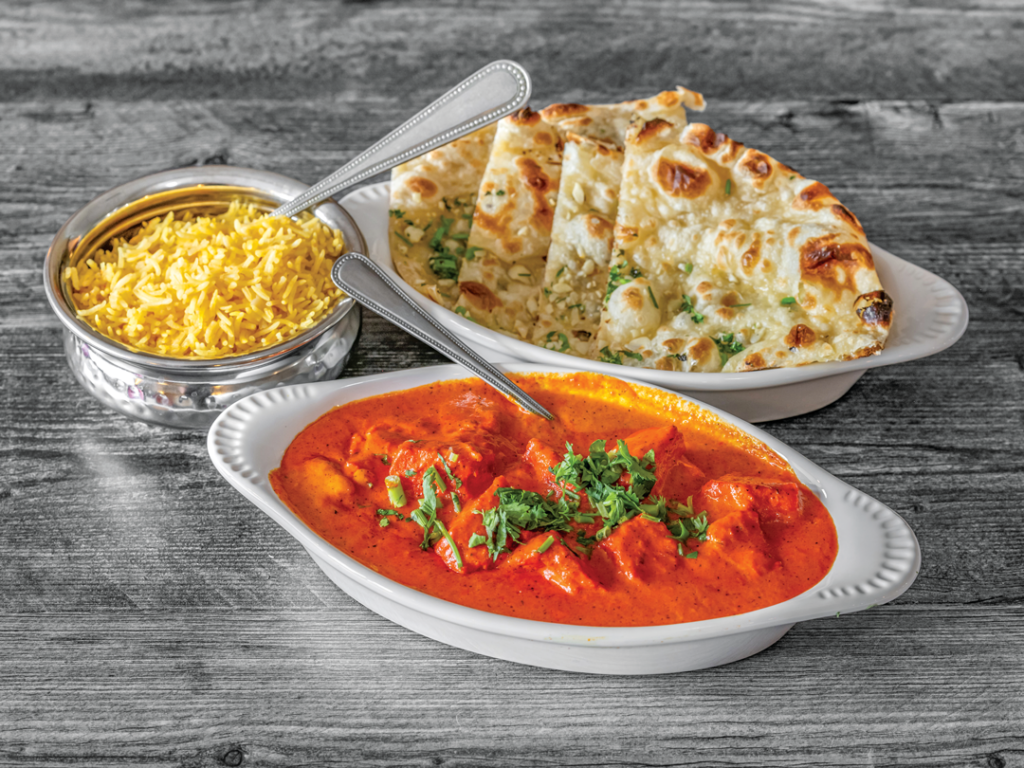
Chicken tikka Bhansa Restaurant.
“In Kathmandu, customers don’t eat creamy food, like the creamy sauce in Bhansa’s most popular dish, tikka masala, or saag paneer, which has creamed spinach, tofu and ground spices,” Rupesh says. “We also have five spice levels from Indian-sourced chili powder, ranging from mild to Indian hot. The last level is just a little bit more than extra hot.”
The restaurant is decorated with images of Nepal: the mountains surrounding Kathmandu (including Mount Everest), farmers working the harvest, religious temples, Buddha (who was born in Nepal) and Teej, one of the country’s many festivals. A handful of statues also underscore the culture.
“Teej celebrates women’s culture,” Rupesh says. “They wear a red dress (or the traditional sari) and fast for the long life of their husband,” he says.
Festival-specific foods can be ordered for take-out during the different celebrations, including goat curry, a Nepalese favorite that isn’t on the regular menu. Instead, a lamb curry takes its place.
“Most Nepali people like the taste of goat better than lamb,” Rupesh says. “Goat is tougher and takes longer to cook.”
As his restaurant gains more regulars, Rupesh hopes to feature other festival specialties on the menu. Possibilities include achar, a pickled mix of potatoes, carrots and cucumber spiced with cumin and coriander, and roti, a fried bread ring made with rice, sugar and ghee, a type of clarified butter.
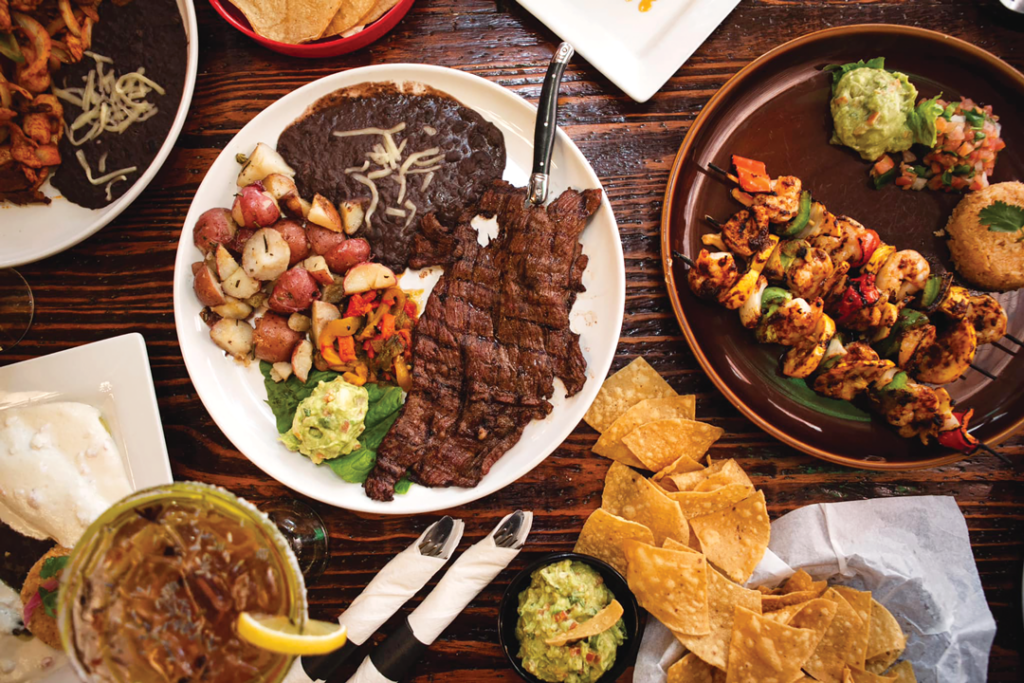
Carne asada is one of La Buena Vida’s signature dishes.
La Buena Vida and Los Tarascos – Fort Collins
After a drug cartel tried to kidnap Hugo and Maria Caballero’s eldest daughter, Priscilla, at age 4, in Aptzingán, Michoacán, they packed up their three children and their belongings and immigrated to the U.S. in April 1995.
The couple, both chefs who owned two seafood restaurants in Aptzingán, believed they had no choice but to run.
“At that time, the drug cartel in town threatened people to pay them every month, and we didn’t want to continue doing that,” Hugo says.
Hugo was raised in the restaurant business. He worked in his mother’s seafood restaurants before he and Maria opened their own. His mother still lives in Michoacán.
“My mom is a very well-known person in town,” Hugo says. “The cartel knows where to go and who to touch. My mom, she’s not one of them.”

Hugo and Maria Caballero. Photo by Jordan Secher.
After moving their young family to Fort Collins, Hugo and Maria decided to open a restaurant serving authentic dishes from Michoacán rather than just seafood because they were no longer near the ocean.
“It was a hard time to show what the foods of the south were,” Hugo says. “There was Tex-Mex here at the time. We don’t use big amounts of cheese or sour cream, only a tiny amount of oil. I told my wife, ‘I don’t know what to do here.’”
But as more Americans traveled deeper into Mexico, Hugo says they learned about the food culture, one recognized by the United Nations Educational, Scientific and Cultural Organization as “Tierra Caliente” (“Hot Land” in Spanish), a region celebrated for its culinary contributions to Mexican cuisine.
Hugo says his two restaurants, La Buena Vida (opened 2015), now managed by his son, Hugo, Jr., and Los Tarascos (opened 1995), which Priscilla now owns, don’t serve Americanized food. Gema, their youngest, manages Los Tarascos.
“Carne asada at other Mexican restaurants was made on the flat grill,”
Hugo says. “It’s supposed to be charbroiled. Our sauces are from fresh tomatoes, not canned, that we roast every day.”
Every day over a three-day period, the family roasts 30 pounds of tomatoes, 10 pounds of jalapeños and 120 poblanos for a chile relleno dish blanketed with poblano cream sauce.
Other popular dishes are carnitas, pollo a la parrilla (charbroiled chicken) and the Michoacán version of mole: a rich sauce made from 20 ingredients, including dried guajillo chiles, chile pasilla, sweet chile campana, pumpkin seeds and spices. The mole takes about six hours to cook.
Hugo admits that, over the years, he’s relented somewhat on serving only foods from Michoacán.
“When we first opened, a customer asked for sopapillas, and another one asked for chimichangas. I told them I didn’t know what those were,” he says. “We don’t have that in the south, the chimichangas, they’re too greasy. It’s not how we cook.”
He eventually added sopapillas to the dessert menu. But if you want a sweet end to your meal, he recommends ordering La Buena Vida’s baked pineapple flan finished with a caramelized topping and whipped cream. As with all the best things, it has a cherry on top.







